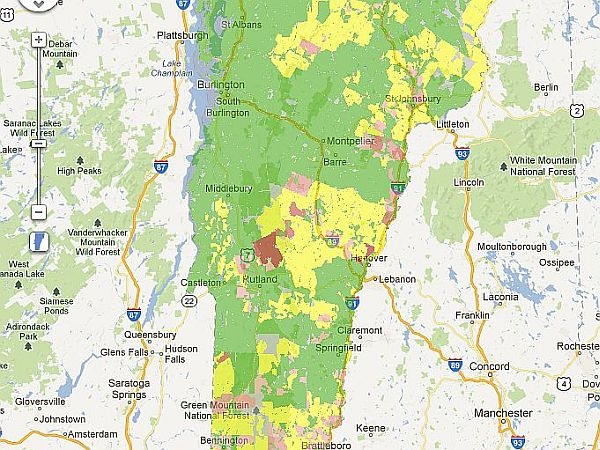
A few eyebrows were raised last month when the state announced that fully 95 percent of homes, businesses and institutions in Vermont are served by broadband.
The 95 percent figure is based on a complex mapping project that involves dozens of businesses and organizations. And there is an asterisk or two next to it.
The mapping is done under the terms of a federal grant from the National Telecommunications And Information Administration.
The most recent map from June of last year shows the areas of the state with broadband shaded in green. The 95 percent figure is for fixed broadband. It doesn’t include mobile or satellite broadband.
The broadband mapping job falls to the Vermont Center For Geographic Information, a state supported public non-profit.
According to Executive Director David Brotzman here’s how the map is compiled:
First, Vermont’s roughly 40 broadband service providers report coverage information to the center.
Brotzman says the next step is verifying the information.
"The provider gives us data, and the we have the Center For Rural Studies at the University of Vermont and they will do call surveys and say, ‘do you have broadband?’" he explains.
Invariably discrepancies turn up that show people don’t have coverage. This information is given to the providers.
Brotzman says the discrepancies and the sampling size of the call-outs are used to calculate the overall accuracy of the coverage map.
"People say, ‘the maps are wrong’. We know that the maps are wrong. Statistically they’re about 85 percent correct," he says.
That doesn’t mean that 15 percent of the data is incorrect. It means there is a 15 percent chance that the broadband information for a particular location is inaccurate. That meets the accuracy standards of the National Telecommunications And Information Administration.
There are also factors that fly under the radar of the mapping project and can contribute to inaccuracy. For example, in some cases the capacity of the broadband infrastructure can limit how many customers can be served even though an area is shaded in green.
Caro Thompson of the Vermont Telecommunications Authority says trying to map more than 295,000 individual locations in Vermont the get the clearest picture of broadband service is a daunting task.
"In terms of what’s possible within our current structure of business and government and funding streams, we are getting as much information as we can. 295,000 addresses is a lot of information," she says.
Thompson says 12,494 addresses have been identified as still without broadband access, with plans to connect them in the coming year.
The Vermont broadband coverage map doesn’t consider the cost or speed of broadband service. Thompson says keeping costs down is the idea behind the millions in state and federal funding that have been poured into helping providers build out broadband in Vermont.
State officials acknowledge that after the state declares 100 percent broadband coverage, which it hopes to do by year’s end, it may discover that some Vermonters still can’t get service.
They’re confident that number will be small and ways will be found to serve those locations.